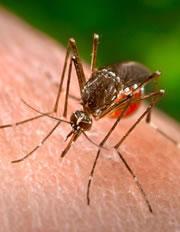What's new?
 Aedes aegypti looks different and has a much different genome to its malaria-carrying cousin.James Gathany, CDC
Aedes aegypti looks different and has a much different genome to its malaria-carrying cousin.James Gathany, CDCToday scientists officially release the genome sequence of one of humanity's least beloved neighbours: the mosquito Aedes aegypti. A preliminary analysis of the sequence is published online in the journal Science1, opening the floodgates on a variety of different research approaches aimed at controlling the insect and the diseases it carries.
Wait — this sounds awfully familiar. Didn't they already do this?
They sequenced the Anopheles gambiae genome four and a half years ago2. That was a totally different mosquito.
Are they really so different?
The key distinction between the two is that a bite from a female A. gambiae can give you malaria, whereas a bite from A. aegypti could give you yellow fever or dengue. They also look very different.
The two mosquitoes diverged in evolution about 150 million years ago. "They are about as different as you can get in the mosquito world," says David Severson, a biologist at the University of Notre Dame in Indiana who participated in both sequencing projects. "They've had a long time to go off and do their own thing."
During that time, the A. aegypti genome swelled to 1.38 billion base pairs, five times the size of A. gambiae's genome (a third the size of the human genome). But the two mosquitoes have approximately the same number of genes.
What have researchers managed to do with the A. gambiae sequence so far?
Researchers have taken a variety of different strategies for using the A. gambiae genome sequence to further their attempts to control malaria. For example, molecular entomologist Flaminia Catteruccia of Imperial College London has been trawling through the A. gambiae genome in search of genes responsible for sex determination. Her ultimate goal is to flood wild mating populations with sexually active but genetically sterile male mosquitoes.
Meanwhile, Liangbiao Zheng of Yale University in New Haven, Connecticut, has been using the sequence to study the interactions between the mosquito and the malaria parasite. The hope is to use information about how the parasite evades the mosquito's immune defences to find ways to bolster A. gambiae 's defences against malaria. Zheng and his colleagues have found several key genes that regulate the mosquito's response to infection. They are also comparing strains of A. gambiae that vary in their degree of resistance to the parasite, in the hope of finding the genetic regions responsible for increased or decreased immunity.
Has anyone worked out how to stop the mozzies from biting humans?
Some have focused their research on this, yes, with an eye to developing new insect repellents or to creating A. gambiae strains that can't hone in on their next human meal. Several studies have surveyed the genome for possible olfactory genes and have come up with a list of new targets.
Has any of this translated into practical applications?
It will be a long time before most of these findings can make the lab-to-field leap. "It isn't like 'We have the genome so now we can solve everything'," says Vishvanath Nene, a researcher at the J. Craig Venter Institute who worked on the A. aegypti genome. "But we are a step closer."
One technology that could make this leap soon is a method that uses gene expression patterns to determine whether a mosquito is resistant to insecticides. The traditional way of screening for insecticide resistance relied on testing individual mosquitoes against many, many individual herbicides. Using gene expression instead would speed up the process.
Are there other mosquito genomes out there too?
Early drafts of a genome sequence from Culex pipiens, the mosquito that carries elephantiasis and West Nile disease, are available.
And are there more to sequence?
Lots. There are about 3,500 species of mosquitoes, in three subfamilies — Anophelinae, Culicinae and Toxorhynchitinae. The three sequenced mozzies mentioned above fall into the first two subfamilies. Of them, only C. pipiens is common in North America or Europe.
ADVERTISEMENT
There's actually more work to be done on A. gambiae too. The genome they sequenced turns out to have come from a lab strain that was actually a hybrid of two common subspecies. So now they have to sequence them individually to get the full picture.
What about other insects?
A motley crew of other unpleasant bloodsucking disease-carriers is already crowding the sequencing pipeline. At various stages in the sequencing process are: the deer tick, a scourge particularly in the United States because it can carry the bacterium that causes Lyme disease; the body louse, which can cause epidemic typhus; two different sand flies that can transmit leishmaniasis; and the tsetse fly, which can spread African sleeping sickness.
Visit our genomeleaves_researc.html">newsblog to read and post comments about this story.
